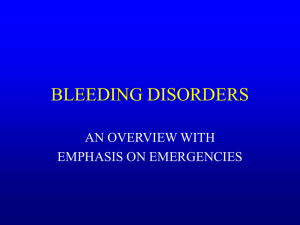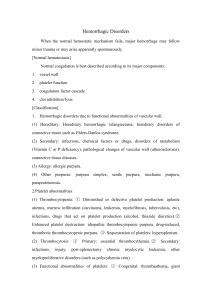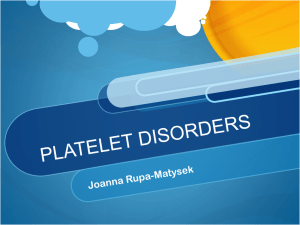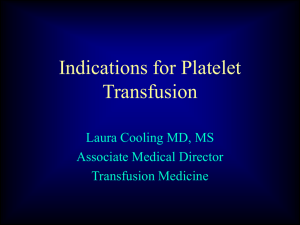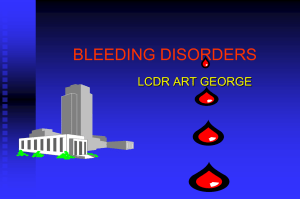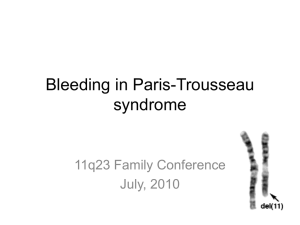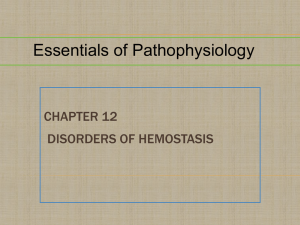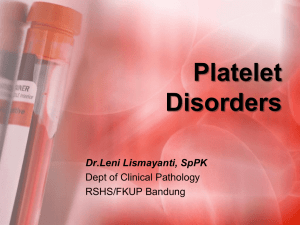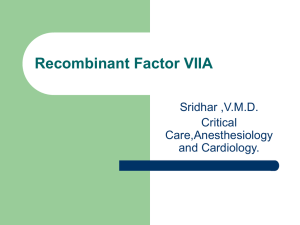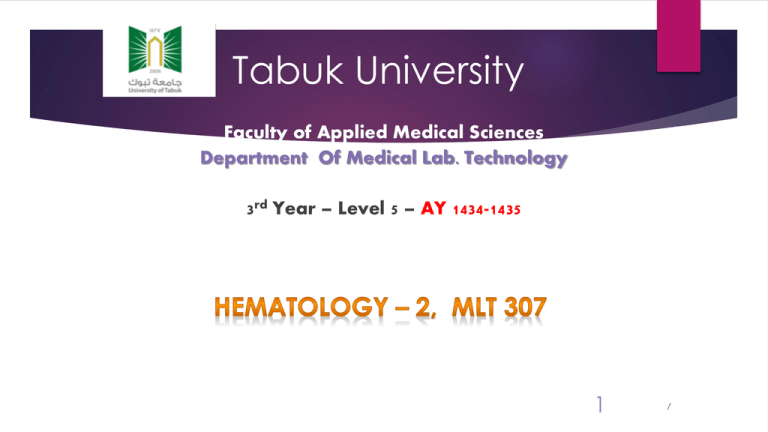
Tabuk University
Faculty of Applied Medical Sciences
Department Of Medical Lab. Technology
3rd Year – Level 5 – AY 1434-1435
1
1
2
Bleeding disorders
caused by vascular and platelets
abnormalities
By/
Dr. Walid ZAMMITI; Phd
M.Sc; MLT
Objectives
3
To have a look on the clinical aspects of bleeding, and to be able to distinguish
between different types of bleeding disorders.
Be aware of the rare inherited coagulation disorders.
Classify and categorize Bleeding disorders caused by vascular and
platelets abnormalities.
List the causes of thrombocytopenia.
Discuss the diagnosis of Bleeding disorders caused by platelets
abnormalities
Introduction
Abnormal bleeding may result from:
1 .Vascular disorders;
2 .Thrombocytopenia;
3 .Defective platelet function; or
4 .Defective coagulation.
The pattern of bleeding is predictable depending on the
aetiology. Vascular and platelet disorders : associated with
bleeding from mucous membranes and into the skin.
coagulation disorders: bleeding is often into joints or soft
tissues.
4
Clinical differences between diseases of platelets/wall vessels
or coagulation factors
Finding
Platelet/Vessel walls Coagulation
Mucosal bleeding
Petechiae
Deep haematomas
Bleeding from skin cuts
Sex of patient
Common
Common
Rare
Persistant
Equal
Rare
Rare
Characteristic
Minimal
>80%
Definition of terms
Bruising
نزفwith mild trauma إصابة
Bruising
without trauma
Petechiae – a : typical of platelet disorders
Ecchymosis – b : the purple or black-and-blue
area resulting from a bruise. Typical of
coagulation factor disorders
Hematoma – c : usually with trauma,
coagulation disorders
6
Petechiae:
tiny pin-point hemorrhages in skin or mucous
membranes due to not enough platelets to plug up the
micro-leaks in small vessels each day
7
Purpura: hemorrhages larger than petechiae
seen in the skin
8
Ecchymosis : the purple or black-andblue area resulting from a bruise
9
Vascular bleeding disorders
Vascular disorders are a heterogeneous group of conditions characterized by easy
bruising and spontaneous bleeding from the small vessels,
The underlying abnormality is either in the vessels themselves or in the
perivascular connective tissues.
Most cases of bleeding caused by vascular defects alone are not severe.
Frequently, the bleeding is mainly in the skin causing petechiae, ecchymoses or
both.
Inherited or acquired
11
Inherited vascular disorders
Hereditary haemorrhagic telangiectasia.
Connective tissue disorders.
Giant cavernous haemangioma
Hereditary haemorrhagic telangiectasia
Transmitted as an autosomal dominant trait.
Dilated micro vascular sweelings which appear during childhood
and become more numerous in adult life.
Telangiectasisa develop in the skin, mucous membranes and
internal organs.
13
Connective tissue disorders
Pseudoxanthoma elaticum is associated with arterial haemorrhage
and thrombosis.
Mild cases may present with superficial brusing and pupura
following minor trauma.
Giant cavernous haemangioma
These congenital malformation occasionally cause chronic
activation of coagulation to laboratory features of disseminated
intravascular coagulation (DIC).
In same cases thrombocytopenia
Acquired vascular defects
16
Simple easy bruising is a common benign disorder which occurs in
otherwise healthy women, especially those of child-bearing age.
Senile purpura caused by atrophy of the supporting tissues of cutaneous
blood vessels is seen mainly on dorsal aspects of the forearms and hands.
Purpura associated with infections.(immune complex formation)
Scurvy. vitamin C deficiency
Acquired vascular defects
17
1.
Simple easy bruising is a common benign disorder which occurs in
otherwise healthy women, especially those of child-bearing age.
2.
Senile purpura caused by atrophy of the supporting tissues of
cutaneous blood vessels is seen mainly on dorsal aspects of the
forearms and hands.
3.
Purpura associated with infections.(immune complex formation).
4.
Scurvy. vitamin C deficiency
Platelets disorders : 1. Thrombocytopenias
Characterized by spontaneous skin purpura and mucosal
haemorrhage and prolonged bleeding after trauma.
18
19
Causes of thrombocytopenia
Failure of platelet production
1.
Megakaryocyte depression (congenital defects drugs, chemicals, viral infections).
2.
Part of general bone marrow failure (cytotoxic drugs, radiotherapy, aplastic
anaemia, leukaemia, myelodysplastic syndromes, myelofibrosis, megaloblastic
anaemia)
Increased consumption of platelets (immune, DIC, TTP, ITP)
Abnormal distribution of platelets (Splenomegaly)
Dilutional loss (Massive transfusion of stored blood to bleeding patients )
20
Thrombocytopenia in Megaloblastic anemia
21
Immune Thrombocytopenic Purpura (ITP)
The most common cause of acute thrombocytopenia in children.
Cause
Antiplatelet antibodies
Antigen - platelet membrane glycoprotein complexes IIb-IIIa and Ib-IX
Morphology
Peripheral Blood
Marrow
thrombocytopenia, abnormally large platelets (megathrombocytes or Giant platelets),
Normal or Increased magakaryocyte number
Diagnosis - by exclusion
Bleeding time - prolonged, but PT & PTT - normal
22
Thrombotic Thrombocytopenic Purpura
Is a rare condition characterized by the formation of small clots (thrombi) in the
circulation, resulting in the consumption of platelets (thrombocytopenia).
This is due to a lack of enzyme activity, called vWF cleaving protease, that breaks
down von Willebrand factor into smaller molecules.
In TTP, vWF is synthesised normally, but its subsequent break down (cleavage) is
defective. Circulating large vWF molecules leads to the inappropriate formation of
platelet clumps (thrombi).
Hemolysis, thrombocytopenia, fever, neurological and renal abnormalities.
23
2. Disorders of platelet function: THROMBOCYTOPATHY
Disorders of platelet function are suspected in
patients who show skin and mucosal haemorrhage
and in whom the bleeding time is prolonged
despite a normal platelet count.
These disorders may be hereditary or acquired.
Hereditary disorders
24
Thrombasthenia (Glanzmann's disease):
Failure of primary platelet aggregation because of deficiency of membrane GPIIb
Bernard-Soulier syndrome:
Large platelets with defective binding to VWF, defective adherence to exposed
subendothelial connective tissues and platelets do not aggregate with ristocetin
Storage pool diseases:
Absence of α OR dense granules.
Acquired disorders
25
Antiplatelet drugs: Aspirin is the most common; causing Abnormal
Bleeding Time.
Hyperglobulinaemia: interfer with platelet adherence, release and
aggregation.
Myeloproliferative and myelodysplastic disorders : essential
thrombocythaemia and other myeloproliferative and myelodysplastic
diseases
Uraemia: associated with various abnormalities of platelet function.
Diagnosis of platelet
disorders
26
27
When the blood count, including platelet
count and blood film examination, are normal,
a PFA-100 (platelet function analysis) or, much
less frequently, a bleeding time is used to
detect abnormal platelet function.
PFA-100 System
Measures the complex process of
primary hemostasis and aids in the
rapid detection of platelet
dysfunction.
28
29
Rare hereditary defects of platelet function
These are detected using :
1.
Platelet aggregation studies (Light transmission aggregometry
using PRP)
2.
Nucleotide pool measurements (specific deficiency in dense
granule numbers or their content (e.g. storage pool disease), or
specific defect(s) in degranulation )
3.
Flow cytometry (quantification of glycoprotein receptor density ,
e.g in BSS)
** If von Willebrand disease is suspected, assay of VWF and
coagulation factor VIII are required.
H.W
A 28-year-old woman has a 3-month history of easy bruising and bleeding gums. She feels otherwise well. Medical
and family histories are unremarkable, and she takes no medications.
On physical examination, temperature is normal. Petechiae are present on the buccal mucosa and pretibial areas,
and ecchymoses are noted on the upper thighs. There is no lymphadenopathy or splenomegaly.
Laboratory studies:
Hemoglobin 10.4 g/dL (104 g/L)
Leukocyte count 5200/µL (5.2 × 109/L)
Absolute neutrophil count 1200/µL (1.2 × 109/L) (normal >1500/µL [1.5 × 109/L])
Platelet count 18,000/µL (18 × 109/L)
Reticulocyte count 0.9% of erythrocytes
Direct antiglobulin (Coombs) test Negative
A peripheral blood smear shows no circulating blasts. The platelets are decreased and are not clumped and
enlarged. Bone marrow examination shows hypoplastic marrow (<20% cellularity) with trilineage normoblastic
maturation and normal iron stores. There are no findings suggesting an infiltrative disease and no increases in CD34
blasts or reticulin fibrosis.
Which of the following is the most likely diagnosis?
A) Acute myeloid leukemia
B) Aplastic anemia
C) Immune thrombocytopenic purpura
D) Myelodysplastic syndrome
Please explain.


